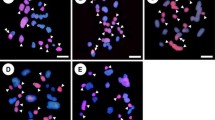Abstract
Some intergeneric hybrids produced by the crosses among several colchicaceous ornamentals, Gloriosa superba ‘Lutea’ (2n = 2x = 22), G. ‘Marron Gold’ (2n = 4x = 44), G. ‘Verschild’ (2n = 7x = 77), Littonia modesta Hook. (2n = 2x = 22), and Sandersonia aurantiaca Hook. (2n = 2x = 24), were subjected to genomic in situ hybridization (GISH) analysis in order to clarify their genome constitutions. Chromosome preparation was made from root tip cells of L. modesta × G. superba ‘Lutea’, L. modesta × S. aurantiaca, S. aurantiaca × G. superba ‘Lutea’, L. modesta × G. ‘Marron Gold’, S. aurantiaca × G. ‘Marron Gold’ and G. ‘Verschild’ × S. aurantiaca. Total DNA of one parent was labeled with digoxigenin or biotin and used as probe, and chromosomes were counterstained with 4′-6-diamidono-2-phenylindole (DAPI). For all the nine intergeneric hybrids, chromosomes from each parent could be clearly distinguished by GISH analysis. Thus GISH analysis is a powerful tool for identifying the genome constitution of intergeneric hybrids in colchicaceous ornamentals. The results obtained by GISH analysis study may be important for further progress in breeding of colchicaceous ornamentals.


Similar content being viewed by others
References
Amano J, Kuwayama S, Mizuta Y, Oomiya T, Nakamura T, Nakano M (2007) Early identification of intra- and intergeneric hybrids among Colchicaceous ornamentals, Gloriosa spp., Littonia modesta Hook. and Sandersonia aurantiaca Hook., by flow cytometry and random amplified polymorphic DNA analyses. J Japan Soc Hort Sci 76:73–78
Amano J, Kuwayama S, Mizuta Y, Godo T, Okuno H, Nakano M (2008) Morphological characterization of three intergeneric hybrids among Gloriosa superba ‘Lutea’, Littonia modesta and Sandersonia aurantiaca (Colchicaceae). Hort Sci 43:115–118
Amano J, Nakazawa D, Kuwayama S, Mizuta Y, Okuno H, Watanabe Y, Godo T, Han D-S, Nakano M (2009) Intergeneric hybridization among colchicaceous ornamentals. Gloriosa spp., Littonia modesta and Sandersonia aurantiaca via ovule culture. Plant Biotechnol 26:535–541
Barba-Gonzalez R, Lokker AC, Lim K-B, Ramanna MS, Van Tuyl JM (2004) Use of 2n gametes for the production of sexual polyploids from sterile Oriental × Asiatic hybrids of lilies (Lilium). Euphytica 109:1125–1132
Barba-Gonzalez R, Ramanna MS, Visser RGF, Van Tuyl JM (2005) Intergenomic recombination in the F1 lily hybrids (Lilium) and its significance for genetic variation in the BC1 progenies as revealed by GISH and FISH. Genome 48:884–894
Deng Y, Chen S, Lu A, Chen F, Tang F, Guan Z, Teng N (2010) Production and characterization of the intergeneric hybrids between Dendranthema morifolium and Artemisia vulgaris exhibiting enhanced resistance to chrysanthemum aphid (Macrosiphoniella sanbourni). Planta 231:693–703
Fukui K, Nakayama S (1996) Plant chromosomes laboratory methods. CRC Press, Boca Raton
Gadella TWJ (1987) Sexual tetraploid and apomictic pentaploid populations of Hieracium pilosella (Compositae). Plant syst Evol 157:219–245
Ji Y, Pertuze R, Chetelat RT (2004) Genome differentiation by GISH in interspecific and intergeneric hybrids of tomato and related nightshades. Chromosom Res 12:107–116
Khan N, Zhou S, Ramanna MS, Arens P, Herrera J, Visser GF, Van Tuyl JM (2009) Potential for analytic breeding in allopolyploids: an illustration from Longiflorum × Asiatic hybrid lilies (Lilium). Euphytica 166:399–409
Kuwayama S, Nakamura T, Mizuta Y, Oomiya T, Nakano M (2005) Cross-compatibility in interspecific and intergeneric hybridization among the Colchicaceous ornamentals. Gloriosa spp., Littonia modesta and Sandersonia aurantiaca. Acta Hort 673:421–427
Marasek A, Okazaki K (2008) Analysis of introgression of the Tulipa fosteriana genome into Tulipa gesneriana using GISH and FISH. Euphytica 160:217–230
Marasek A, Hasterok R, Wiejacha K, Orlikowska T (2004) Determination by GISH and FISH of hybrid status in Lilium. Hereditas 140:1–7
Marasek A, Mizuochi H, Okazaki K (2006) The origin of Darwin hybrid tulips analyzed by flow cytometry, karyotype analyses and genomic in situ hybridization. Euphytica 151:279–290
Marasek-Ciolakowska A, Ramanna MS, Ter Laak WA, Van Tuyl JM (2010) Genome composition of ‘Elatior’-begonia hybrids analyzed by genomic in situ hybridization. Euphytica 171:273–282
Markova M, Michu E, Vyskot B, Jitka Zluvova BJ (2007) An interspecific hybrid as a tool to study phylogenetic relationships in plants using the GISH technique. Chromosom Res 15:1051–1059
Nakamura T, Kuwayama S, Tanaka S, Oomiya T, Saito H, Nakano M (2005) Production of intergeneric hybrid plants between Sandersonia aurantiaca and Gloriosa rothschildiana via ovule culture (Colchicaceae). Euphytica 142:283–289
Parokonny AS, Marshall JA, Bennett MD, Cocking EC, Davey MR, Brian Power J (1997) Homoeologous paring and recombination in backcross derivatives of tomato somatic hybrids [Lycopersicon esculentum (+) L. peruvianum]. Theor Appl Genet 94:713–723
Saito H, Mizunashi K, Tanaka S, Adachi Y, Nakano M (2003) Ploidy estimation in Hemerocallis species and cultivars by flow cytometry. Sci Hort 97:185–192
Schwarzacher T, Leitch AR, Bennett MD, Heslop-Harrison JS (1989) In situ localization of parental genomes in a wide hybrid. Ann Bot 64:315–324
Takahashi C, Leitch IJ, Ryan A, Bennett MD, Brandham PE (1997) The use of genomic in situ hybridization (GISH) to show transmission of recombinant chromosomes by a partially fertile bigeneric hybrid, Gasteria lutzii × Aloearistata (Aloaceae), to its progeny. Chromosoma 105:342–348
Tang F, Chen F, Chen S, Wang X, Zhao H (2010) Molecular cytogenetic identification and relationship of the artificial intergeneric hybrid between Dendranthema indica and Crossostephium chinense by GISH. Plant Syst Evol 289:91–99
Zhou S, Ramanna MS, Visser GF, Van Tuyl JM (2007) Genome composition of triploid lily cultivars derived from sexual polyploidization of Longiflorum × Asiatic hybrids (Lilium). Euphytica 160:207–215
Acknowledgments
This work was supported in part by a Grant-in-Aid for Scientific Research (No. 20580023) from the Ministry of Education, Culture, Sports, Science and Technology, Japan. We are grateful to Mr. Shiro Mizogami, Keyence Corp., Japan, for his valuable suggestions.
Author information
Authors and Affiliations
Corresponding author
Rights and permissions
About this article
Cite this article
Nakazawa, D., Kishimoto, T., Sato, T. et al. Genomic in situ hybridization (GISH) analysis of intergeneric hybrids in Colchicaceae. Euphytica 181, 197–202 (2011). https://doi.org/10.1007/s10681-011-0393-2
Received:
Accepted:
Published:
Issue Date:
DOI: https://doi.org/10.1007/s10681-011-0393-2




